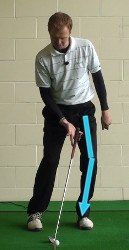
Chipping
Distance control is a crucial aspect of chipping in golf. Being able to consistently control the distance of your chip shots can greatly improve your short game performance. Here are some key tips and techniques for improving your chipping distance control:
- Club Selection: Choose the appropriate club based on the distance you need to chip the ball. Generally, you'll use a pitching wedge, gap wedge, or sand wedge for chipping. Become familiar with the distance each club carries and rolls out on the greens by practicing different shots with each club.
- Develop a Pendulum Motion: Focus on creating a smooth and controlled pendulum-like motion with your chipping stroke. The motion should be relatively short and compact, with the arms and wrists working together in a connected manner. Avoid excessive wrist or hand movement, as it can lead to inconsistent distance control.
- Use a Land Spot as a Reference: Instead of solely focusing on the flagstick or the hole, pick a specific spot on the green where you want the ball to land. This spot should be your target, as it allows you to control the rollout and have a better sense of distance. Visualize the trajectory and landing spot before executing your chip shot.
- Control Swing Length: The length of your backswing and follow-through can significantly affect the distance of your chip shots. Experiment with different swing lengths to control the distance. For shorter shots, your backswing and follow-through should be shorter, while longer shots may require a slightly longer swing. Focus on consistent tempo and rhythm.
- Vary Your Technique: Different situations on the golf course call for different chipping techniques. Experiment with a variety of techniques, such as using different clubs, altering your setup, or adjusting your ball position. By developing a versatile repertoire of chipping techniques, you'll have more options to control distance depending on the lie and conditions.
- Practice with Targets: Set up targets at various distances on the practice green or use alignment aids to develop a sense of distance control. Start with shorter chips and gradually work your way up to longer distances. Practice hitting specific targets or landing spots to fine-tune your ability to control the distance of your chip shots.
- Pay Attention to Green Conditions: Different green conditions, such as firmness, speed, and slope, can affect the rollout of your chip shots. Take note of the green conditions during practice rounds or warm-ups and adjust your technique and club selection accordingly to achieve the desired distance control.
- Focus on Feel: Developing a sense of feel and touch is essential for chipping distance control. Pay attention to the feedback your body provides, such as the weight and tempo of your swing, the contact with the ball, and the rollout after impact. Over time, you'll develop a better instinct for the required swing length and power for different distances.
- Practice Under Pressure: Incorporate pressure situations into your chipping practice. Create challenging scenarios that simulate on-course pressure, such as playing a game or setting specific targets with consequences for missing. Practicing under pressure helps simulate real on-course conditions and trains your ability to control distance effectively.
- Seek Professional Guidance: Working with a golf instructor can provide valuable guidance and feedback on your chipping distance control. They can help analyze your technique, suggest adjustments, and provide specific drills and exercises tailored to your needs.
Remember, consistency and practice are key to improving your chipping distance control. By implementing these tips, dedicating time to practice, and honing your feel and touch around the greens, you can enhance your ability to control the distance of your chip shots and improve your overall short game performance.





